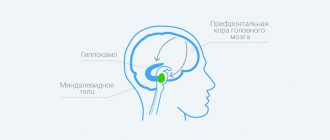Pseudodementia - symptoms
The main symptoms of pseudodementia include:
- speech problems
- memory losses
- difficulty paying attention
- difficulty regulating emotions
- difficulties with organization and planning
These symptoms are very common in people with dementia. Therefore, a doctor may diagnose and treat these people as if they had dementia.
Because pseudodementia is often associated with depression, a person may also have symptoms that include:
- loss of interest in activities
- depressed mood that lasts for weeks
- social isolation
- suicidal thoughts or behavior
- insomnia or hypersomnia
- general fatigue
- loss of appetite or overeating
This condition usually occurs in people as they age. Some speculate that mood-related conditions such as depression may cause these cognitive changes in the aging brain.
Pseudodementia is a reversible dementia. How to diagnose the condition and help the patient?
The concept of pseudodementia means false dementia, which is a special mental disorder in the form of a complex of symptoms (syndrome) reminiscent of true dementia (dementia).
This condition was first described by the German psychiatrist Wernicke. He also proposed the term itself in order to distinguish it from true dementia, associated with organic damage to the cerebral cortex.
Therefore, the disorder was also named after its name - Wernicke's pseudodementia.
Causes and mechanism of development
This syndrome is essentially a hysterical psychogenic reaction (hysterical pseudodementia). Its symptoms are in many ways similar to the psychopathological hysterical syndrome with twilight clouding of consciousness (Ganser syndrome) and to one of the forms of reactive hysterical psychosis, accompanied by childish actions and statements (the so-called puerilism).
Pseudodementia syndrome belongs to a subgroup of psychogenic psychoses of the group of reactive states, also called stress reactions, psychogenic reactions, abnormal reactions, etc.
As a reactive state, it has the character of reversible mental disorders, which are a response to a traumatic effect, in contrast to true dementia.
The latter is associated with organic brain damage, manifested by a decrease in short-term and long-term memory, as well as some other symptoms.
In other words, if the cause of dementia is organic brain damage, then false dementia is a functional disorder of a protective nature, the cause of which is mental trauma. False dementia can develop at any age, including in children, but it is most often observed among older people.
The main causative and provoking factors in the development of pseudodementia, according to psychiatrists, are:
- Prolonged stay in a traumatic situation.
- A short-term but quite intense traumatic effect on the human psyche.
- Protracted or intractable conflict.
- Local (most often) external events that are perceived as a personal life disaster.
Contributing factors that significantly increase the likelihood of occurrence of the mental disorder in question:
- Personality characteristics of the patient, which include other moderately severe disorders such as psychopathy, or personality characteristics that are within the boundaries of a clinically normal state (accentuation of personality character). Most often, false dementia develops in people with epileptoid or hysterical character traits. Pseudodementia is somewhat less common in schizophrenia, as well as among cycloid personality types, characterized by undulating changes in mood and corresponding behavior.
- Various acquired mental disorders, for example, psychogenic depression.
- The presence of a psycho-like state or a decrease in intelligence at a certain distant time after a traumatic brain injury.
Presumably, the essence of the mechanism of development of the disorder is that in the presence of a cause, provoking and contributing factors, for example, the perception of the impossibility of a positive resolution of a stressful situation, two negative foci of excessively high activity are formed in the cerebral cortex.
As a result, a widespread process of inhibition occurs in the remaining parts of the cortex. It affects higher cognitive functions (perception, memory, attention, speech, etc.) in approximately the same way as destructive organic processes in brain tissue in the frontal lobes during dementia.
However, in this case, the process itself is functional and completely reversible.
Thus, the development mechanism as a hysterical reaction is not a conscious simulation, but a pathological defensive reaction that does not depend on the patient’s wishes and his will.
Symptoms of pseudodementia
Pseudodementia syndrome is more often observed in men. As a rule, its duration ranges from 2 weeks to 3 months, after which the symptoms gradually decrease and recovery occurs. However, sometimes the flow becomes protracted.
In this case, the clinical picture becomes monotonous, monotonous and occurs against the background of partial immobility and sharply reduced speech activity (substupor), and memories of the state of pain are fragmentary and resemble dreams, or are absent altogether, especially in cases of the agitated variant.
The onset of the pathological condition is acute, with the sudden onset of a disorder of judgment, loss of orientation in time and place, the appearance of a feeling of fear and anxiety, which is externally manifested by an attempt to hide or “hide” in a secluded place.
Experiences of a paranoid nature are not excluded, as well as imaginary sensations that are accompanied by unstable frightening auditory, visual, tactile or logical hallucinations, temporary illusory perceptions that seem to be reality and arise in a state intermediate between wakefulness and sleep (hypnagogic hallucinations).
Somewhat later, such patients develop a feeling of confusion, which is manifested by facial expressions, gestures and certain statements.
They are surprised at the sight of ordinary objects, not understanding their purpose, lose the ability to perform ordinary independent actions (go to bed or sit on a chair), eat without using cutlery, and crawl on the floor.
The facial expressions of such a patient are also characteristic - confusion, surprised eyes, meaningless smiles, etc. Individual elements of puerelism often appear in the form of imitation of children's games, grimacing or children's whims (foolishness).
The thinking of such patients is often slow. Answers to questions often follow only after they are repeated several times, and, as a rule, in the form of denial (“I don’t remember,” “I don’t know,” I forgot,” “I didn’t hear,” etc.).
Perseverations are often observed when different questions following one after another are given the same answers that were given to previous questions.
In addition, reading and writing disorders are possible in the form of agrammatisms, missing letters, and uneven handwriting.
The main thing that pseudodementia is characterized in terms of clinical picture is a sudden and pronounced disorder of intellectual function, which is manifested by two main symptoms:
- Incorrect speech, called passing speech, or passing speech, which is incongruous, meaningless answers to posed questions and tasks, which in their essence are clearly understandable to the patient. For example, the patient is unable to correctly answer the question about his location, correctly name the month and current year, time of year, his first and last name, confuses colors and simple names of objects, and is unable to perform the simplest arithmetic operations even with single-digit numbers.
- The inability to reproduce automated skills and perform basic actions is called mimetic action. For example, when asked to sit on a chair, they sit on the floor, past the chair; point to the eyes - they point to the nose, and instead of the leg - to the hand; They tend to put their legs into the sleeves of their shirts, and their hands into socks or trousers, etc.
At the same time, despite the incorrectness of the answers and actions, in all cases they retain a semantic connection with the concepts and objects contained in the psychiatrist’s question, that is, the answers are given within the scope of the topic proposed by the doctor. So, for example, the color black is called white (the answer is within the color of the object), autumn is called winter (within the time of year), they can bend 4 fingers instead of 5, etc.
In the clinical classification, two variants of the pathological condition are distinguished:
Agitated pseudodementia
More often diagnosed in patients with organic lesions of the cerebral cortex.
This form is characterized by an acute onset, pronounced psychomotor agitation, fussiness, restlessness, lack of concentration, making many aimless movements (grimacing and writhing, sorting through clothes and objects), sharp emotional fluctuations, inadequacy of mood from unreasonable euphoria to a state of the same unreasonable alertness, worry, anxiety, fear.
The patient's speech is accelerated, answers to questions are quick and, as a rule, opposite in their semantic meaning. Symptoms of passing words and passing actions are clearly expressed, consciousness has a hysterical character. With a more advanced course, the agitated form is often replaced by puerilism.
Depressive pseudodementia
It develops mainly with depression. It is characterized by its gradual development against the background of an anxious and depressed mood. The patient is confused, sits with wide open eyes in a mournful pose, fearfully looks around, silently cries.
His thought processes are slow, the symptom of passing is accompanied by a predominance of denials and perseverations, and the symptom of passing is of an erased nature, in which the patient experiences significant difficulties in performing simple tasks of the doctor.
For example, in response to a request to raise his right hand, he examines each hand for a long time, as if unable to make a choice, after which he finally raises both hands or one of them.
In the case of the development of a deeper course of the pathological condition, the depressive form of pseudodementia is replaced by psychogenic stupor.
Features of pathology in old and senile age
In old age, degenerative processes occur in the brain due to age-related changes in blood vessels, which leads to the development of various cognitive disorders that accompany many neurological diseases inherent in this age.
At the same time, in some patients, despite relatively normal brain functioning, which corresponds to average age-related changes, mental and, often, physical functions can sharply deteriorate over a relatively short period of time.
Such a rapid development of disorders of the cognitive function of the brain in most cases by relatives, and very often by general practitioners and even neurologists, due to their lack of awareness, is regarded as the development of dementia in old age, which is an inevitable and irreversible condition. But in reality, this condition is caused by false dementia and is quite treatable.
Pseudodementia in older people is most often caused by senile depression in the absence of pronounced degenerative changes in the brain. Senile depression is one of the most common syndromes of elderly and senile age.
It is manifested by a predominant state of lethargy, depression, apathy, loss of interest in people and hobbies, loss of appetite and refusal to eat, weight loss, which is often regarded as an oncological pathology.
In addition, there is an increase in cognitive deficit - a decrease in memory, attention, pace and productivity of thinking. This symptomatology is accompanied by statements of a depressive nature, touchiness and aggressiveness, and inadequacy of the assessment of one’s emotional problems are noted.
With false dementia, a pronounced decrease in intelligence in elderly patients is a significant obstacle to communication with them. At the same time, they demonstrate their indifference and passively reject any possibility of contact with the doctor.
Their condition may be close to depressive stupor.
At the same time, senile depression, and hence the resulting pseudodementia in the absence of significant degenerative brain pathology, is benign and relatively easy to treat.
Principles of treatment of the syndrome
Treatment of pseudodementia in most cases is carried out in an inpatient setting. Medications include antidepressants (in the presence of depression), tranquilizers (in cases of severe agitation in persons with an agitated variant of pseudodementia) and, much less frequently, antipsychotics.
In addition, after eliminating acute manifestations, a psychological form of assistance is used in the form of psychoanalysis, behavioral and group psychotherapy, the essence of which is to identify situations of a traumatic nature, correct behavior and attitude towards them. Physiotherapeutic procedures in the form of electrosleep, massage and other techniques help reduce anxiety and normalize the psychological state.
Eliminating or possibly minimizing the influence of the factor that led to mental trauma is one of the main conditions for successful therapy.
Source: //ponervam.ru/psevdodemenciya.html
Pseudodementia - the cause
Mood-related conditions such as depression are potential causes of pseudodementia. Although a number of causes can lead to pseudodementia, depression is the most common.
As noted in a study published in the journal Annals of Indian Academy of Neurology
, the relationship between depression and pseudodementia is complex. Depression itself can cause cognitive impairment. Likewise, dementia can present with depressive symptoms.
Because of this, many doctors do not consider pseudodementia until they have completely ruled out dementia and other possible causes of these disorders.
In older adults, depression can cause significant cognitive impairment, which may manifest as symptoms associated with pseudodementia.
Although this condition is most often associated with depression, other mental illnesses—such as schizophrenia or dissociative disorder—can cause similar symptoms. The conditions listed above may cause additional symptoms along with the obvious symptoms of dementia.
How is it different from true dementia?
Depressive pseudodementia is a mental disorder of an organic nature that has a negative impact on memory, performance and vital functions.
In most cases, this condition is diagnosed in impulsive and psychologically unstable patients. False dementia is reversible. With this deviation, the patient demonstrates his pain and weakness, thus trying to attract attention to himself. Most often, the disease develops after the age of 50, but there are cases when it occurs at a younger age.
Differences between dementia and pseudodementia:
- Dementia . This deviation develops gradually. Symptoms appear a year after the onset of the disease. Memory deteriorates gradually, the patient becomes disoriented, constantly asks for help, but there are no complaints about his health. The mood changes quickly, and strongly expressed emotions are present. The patient can blame others for anything. Antidepressive therapy does not help.
- False dementia . This deviation develops quickly. Symptoms appear in less than six months. There is fluctuation in memory impairment. Orientation is not impaired, the patient asks for help and knows where to look for it. Subjective complaints are expressed. Depression in the morning, there is a feeling of guilt and hopelessness. Antidepressant therapy helps.
Pseudodementia - diagnosis
Pseudodementia and dementia can be difficult to distinguish between. Many doctors disagree with the use of the term pseudodementia, viewing it as a description of symptoms rather than a diagnosis itself. Because of this, doctors will be very careful before making a diagnosis.
Because symptoms of pseudodementia typically occur in older adults, there are some challenges associated with properly diagnosing the condition. For example, aging itself causes general changes in cognitive processes and brain function. These changes can vary greatly, and it is difficult to tell the difference between changes associated with aging and early signs of depression or dementia.
Another difficulty in diagnosing pseudodementia is that symptoms of depression and many progressive neurological conditions often overlap in older adults. In addition, it is possible that a person has both dementia and depression at the same time.
For this reason, diagnosing pseudodementia may take some time. The doctor must rule out dementia and other cognitive impairment before considering other possible causes.
A thorough diagnosis usually requires a series of tests. An in-office examination can help the doctor understand a person's mental state and what the problem is. This assessment may include testing for:
- memory
- visual perception
- use of language and speech
- problem solving
- attention
- reflexes
- movement and balance
The tests can help the doctor identify the affected area of the brain and proceed with additional testing.
Your doctor may order a blood test to check for signs of underlying conditions. For example, in a person with chronic vitamin B12 deficiency
or
an underactive thyroid gland
may exhibit some similar symptoms. Other times, they check for the presence of certain proteins or compounds in the blood.
In many cases, imaging tests are also an important tool in diagnosing pseudodementia. In cases of dementia, CT scans can indicate underlying causes or show the effects of brain degeneration.
Pseudo-dementia
Pseudo-dementia is an organic mental syndrome characterized by global memory impairment, affecting the quality of life and work.
The main signs of pseudodementia are characterized by complete or severe loss of basic knowledge. The disease is observed in impulsive as well as unstable psychopaths, often without a history of hysterical tendencies. Pseudo-dementia, being a mental disorder, is very similar to dementia (dementia), but is caused by other psychiatric pathologies (schizophrenia, hysteria, depression). Unlike pseudodementia, dementia is irreversible and progressive.
Often the patient wants to show his incapacity and pain. In medicine, this disease is not clearly defined and its main characteristic is the reversibility of memory, as well as other thinking disorders.
This condition often occurs in people over 50 years of age, but cases of its development at a younger age cannot be ruled out.
Pseudo-dementia has a second name - false dementia, and is expressed in the desire to imagine oneself as sick and stupid.
Pseudodementia causes
The disease can be caused by multiple psychiatric pathologies of different nature. The painful condition occurs after protracted conflicts, accidents, and depressive disorders. Knowing the reasons that provoke the disease, it is possible to avoid the development of this disorder. It is important to avoid stress and maintain peace of mind.
The psychological causes of pseudodementia are expressed in the defensive reactions of the patient’s consciousness, which seeks to forget the traumatic situation. A large role in this is given to the mechanisms of repression and self-hypnosis. It is believed that impulsive people are most susceptible to this disorder.
Pseudodementia symptoms
The symptoms of this disorder are often no different from those characteristic of other types of dementia.
Pseudo-dementia and its symptoms: the most common are lost cognitive (mental) functions; the ability to perceive speech, as well as loss of speech, memory impairment with loss of the ability to recognize the immediate environment.
Pseudo-dementia has the development of an acute syndrome, manifested in confusion. During the period of a pronounced illness, patients experience deep disturbances of consciousness, fears, disorientation, and psychogenic speech abnormalities. Depending on the severity of post-traumatic pathology, consciousness narrows, which does not allow you to switch to other thoughts.
Pseudo-dementia intensifies when in contact with people, when patients are paid attention to and remarked upon. Patients may suddenly begin to laugh or grimace. The movements of such people are sharp, angular, and not smooth.
Scientists attribute this trait to destructive phenomena occurring in the frontal lobe of the brain. All these symptoms are temporary, and after a while there comes a period of decreased motor activity.
Foolishness is replaced by an anxious, depressive state, which intensifies when talking with a doctor or medical commissions.
The main symptom of pseudodementia is partial loss of basic knowledge. Those who are ill feel helpless, unable to do anything, unable to remember.
All attempts to remember look confused and resemble a demonstration of the inability to think. Patients make mistakes in basic mental calculations. The most common answer to literally everything is: I don’t know.
The simplest questions asked of patients remain unanswered, but patients are able to answer complex questions unexpectedly. Patients are often depressed, have absurd complaints, labile pulse, tremors, and are prone to hypochondria. Patients tend to have a slow, pained voice.
The facial expression is close to a frozen mask that expresses stupidity, dullness, or shows dissatisfaction and suffering. Often these manifestations are observed in places of detention.
The disease can last a year or more. Prison pseudodementia occurs in a mild form and is characterized by a transient course. The Ganzer twilight state also has similar symptoms. Often pseudodementia occurs some time after the injury. Probably, to begin with, the body internally processes the information received.
Pseudo-dementia needs to be differentiated from conditions such as conscious pretense, imbecility, dementia, and schizophrenia. Sometimes pseudodementia occurs in factitious disorder without any benefit from it. Neuropsychological and psychological examination helps in differential diagnosis of the disease.
Pseudodementia treatment
For depressive symptoms, doctors prescribe antidepressants, but treatment with antidepressants is of little value. This is associated with the development of depression in the earliest stages of Alzheimer's disease. In general, the treatment of pseudodementia is similar to the treatment of hysteria.
A fundamental role is given to eliminating the factors that provoke the onset of the disease. If this cannot be achieved, then psychoanalysis is used, as well as taking sedatives (tranquilizers).
Special methods of physiotherapy are also used to calm the patient.
Often, pseudodementia is effectively cured with the help of group therapy and psychotherapy. In some cases, the patient recovers on his own. Prevention includes avoiding stress, psychological trauma, and maintaining peace of mind. For this purpose, it is recommended to adhere to a healthy lifestyle, get enough sleep, practice self-control, and avoid gambling.
Psychoneurologist Hartman N.N.
Doctor of Medical and Psychological
The information presented in this article is intended for informational purposes only and cannot replace professional advice and qualified medical care. If you have the slightest suspicion that you have pseudodementia, be sure to consult your doctor!
Source: //psihomed.com/psevdodementsiya/
Why does pseudodementia develop?
The causes of the development of classic dementia and false dementia are different. In the first case, pathology begins to develop due to the destruction of brain cells. In the second case, pseudodementia begins due to mental disorders.
Such mental changes can arise as a result of protracted, long unresolved conflicts; short but powerful emotional shocks; a sufficiently long stay in a situation of psychological trauma, prolonged depressive states, etc.
d.
Experts believe that there is no specificity in the development of pseudodementia.
Provoking factors can be completely different reasons - participation in hostilities, any natural disaster, some kind of personal event that is perceived as the downfall of a lifetime, as well as some mental illnesses such as hysteria, psychopathy, schizophrenia, etc.
People who have mild mental disorders, as well as those who have suffered any severe traumatic brain injury, may be susceptible to pseudodementia.
Most often, pseudodementia is a unique ability of the human psyche to protect itself from traumatic circumstances or erase a severe stressful situation from memory. This happens on a subconscious level. The ability of the human consciousness to displace certain negative fragments and self-hypnosis from memory also plays an important role. False dementia is a pathological hysterical reaction that does not depend on the desire and will of the patient.
What are the signs of pseudodementia?
Pseudodementia is divided into two types:
- Agitated pseudodementia. It is characterized by a sudden onset, pronounced psychomotor activity, sharp emotional changes from euphoria to fear, rapid speech and other signs.
- Depressive pseudodementia. It develops slowly, gradually, with a characteristic depressed state and slow speech.
When pseudodementia develops, its symptoms are generally very similar to those of classic dementia. At the very beginning of the disease, the patient is not oriented in place and time, and may try to hide, because... experiences fear and anxiety.
Speech is impaired, sometimes to the point of complete loss. The patient does not perceive other people's speech and may not recognize his closest relatives.
Pseudodementia syndrome may include silly behavior - the patient makes various grimaces, imitates the behavior of a child with whims, disobedience and childish games.
If pseudodementia is of an agitated nature, then most often patients give completely absurd answers to questions, confusing familiar concepts. For example, they call winter summer, pointing to the floor and claiming that it is the ceiling, etc. Characteristic signs of pseudodementia are fleeting and fleeting actions.
- Mimorespeech is incorrect speech. The patient cannot say where he is, what his name is, what month and year it is at a given time, confuses the simplest names and is not able to perform simple arithmetic operations. In this case, the patient does not lose the semantic connection with the question, unlike, for example, schizophrenia.
- Mimic action is a wrong action. The patient loses the ability to perform automated, sometimes simple actions. For example, he puts a glove on his foot, cannot hold a spoon or pen in his hand correctly, puts on clothes backwards, etc. Mimic action may be of an erased nature, i.e. the patient is unable to follow simple commands. For example, if you ask him to raise his left hand, he will look at both of his hands for a long time, as if choosing which one is the left one. As a result, both will rise. This symptom is characterized by pseudodementia in depression.
If in the agitated form of the disease the patient answers questions absurdly, then depressive pseudodementia is characterized by denial - the patient answers all questions “I don’t know”, “I don’t remember”, “I don’t understand”. Another option for depressive pseudodementia is echolalia, i.e. repeating the words spoken by a doctor or other person.
In general, pseudodementia with depression develops quite slowly, lasting about six months. In this case, the patient can navigate in place and time; memory impairment may be unstable. The mood is usually depressed, especially in the morning. The patient may feel guilty and see only hopelessness and desperation around him.
Pseudodementia in older patients is often characterized by increased disinhibition. When pseudodementia develops in older people, symptoms include foolishness, excessive animation, confused speech, active grimacing, and increased lightheadedness.
Regardless of the patient’s age and the form of pathology, pseudodementia has one of the main signs - to emphasize its weakness and pain.
Pseudodementia syndrome is also characterized by the fact that the symptoms are beneficial to the sick person, because thanks to them he can get away from a traumatic situation, attract attention to himself, and obtain additional care from others.
The diagnosis of pseudodementia can only be made by a psychiatrist based on a thorough questioning of not only the patient himself, but also his immediate family, as well as in the presence of symptoms characteristic of pseudodementia. At the same time, pseudodememia must be distinguished from organic dementia, schizophrenia, malingering and other psychiatric diseases that have their own typical symptoms.
Treatment of pseudodementia
Treatment of this type of pathology is carried out in a hospital setting. First of all, because the first condition is the elimination of the traumatic factor.
Drug therapy is prescribed depending on the form of the disease - for the agitated form and depressive pseudodementia, completely different drugs are indicated.
When the acute stage is stopped, psychotherapy and physiotherapy are added.
The prognosis for a disease such as pseudodementia is quite favorable. Recovery is possible within a few months. But, like any other disease, this pathology can and should be prevented with the help of preventive measures. In the modern world it is quite difficult to avoid stressful situations. But it is quite possible to control reactions to them.
First of all, you need to lead the healthiest lifestyle possible and get enough sleep. If there are signs of a prolonged stressful situation, contact specialists in time to prevent favorable conditions for the development of such an illness as pseudodementia.
Source: //xn--d1acamsh7dwd.xn--p1acf/novosti/psevdodementsiya.html
Treatment of pseudodementia
Treatment for pseudodementia can take some time, and people respond differently to treatment. If the doctor has ruled out other possible causes and suspects the person has pseudodementia, therapy will focus on treating the underlying cause.
In many cases, treatment is given for the depression that is causing the symptoms. Treatment for depression involves a combination of psychotherapy and medication. Medicines for depression may include antidepressants and selective serotonin reuptake inhibitors. If these drugs are effective, a person may notice a significant reduction.
Mental health therapy is another important aspect of treating depression. Forms of psychotherapy such as cognitive behavioral therapy or interpersonal therapy can reduce symptoms and address the underlying cause. Even in people whose depression responds well to treatment, symptoms such as cognitive impairment may persist. They may also return over time.
Provoking factors
This disorder of an organic nature can be provoked by various reasons and circumstances that can have a negative impact on the mental state.
Psychological factors:
- defensive reaction of consciousness to a traumatic situation;
- accident;
- conflict with a relative or loved one;
- self-hypnosis
- depression.
Pseudodementia can also occur in patients as a result of a metabolic disorder. It is mainly diagnosed in patients who are very impulsive.
Pseudodementia and dementia - differences
Pseudodementia may look or feel very similar to dementia, but they are very different problems. The main difference between the two is that pseudodementia does not cause actual brain degeneration, while true dementia does. Thus, pseudodementia and dementia will appear differently on brain scans despite causing very similar symptoms.
Differences may also appear during testing. For example, a person with dementia often does not notice that they have memory problems and do not perform well on cognitive tests. A depressed person who has cognitive symptoms may complain of memory problems and perform well on cognitive tests.
In addition, pseudodementia is often treatable. In cases of true dementia, treatment may focus on symptom management, as there are currently no drugs for the condition itself. Treatment may be more or less successful depending on the stage of dementia.
What does it look like in life
The symptoms of this disorder are no different from those of other types of dementia. Very often the patient is not able to answer the most basic questions, this can cause him to panic or hysteria. The main and most common signs include:
- disturbance of mental function;
- speech dysfunction;
- impaired perception of someone else's speech;
- memory impairment up to its loss.
Also, with pseudodementia, the patient becomes more confused. This condition occurs against the background of post-traumatic cognitive and intellectual failure.
When the peak of the disease occurs, the patient experiences severe disturbances of consciousness, which are expressed in disorientation, fears, and speech disorders. There are cases when the patient becomes fixated on one thought.
In old age, pseudodementia manifests itself in the form of severe disinhibition. The patient easily switches from one thing to another, fools around, is too animated, and his facial expressions are pronounced. Speech becomes confused, thoughts are expressed unclearly and with errors. Excitement may increase if you pay attention to the patient and make comments to him. Movements in such a situation will be sharp.
But all of the listed symptoms are present temporarily, after a while they are replaced by reduced motor activity. The patient may experience depression, which will further traumatize the psyche. Facial expressions cease to be expressed. In depressive pseudodementia, the patient responds vaguely.
With a mild degree of impairment, the patient may confuse the names of objects or not remember new information at all. A condition may also occur when the patient does not confuse the names, but describes the object according to its functionality.
Diagnostic features
In modern medicine, several criteria are used that help make a diagnosis of false dementia:
The presence of at least one characteristic sign of deviation:
- decreased ability to think;
- decreased critical perception;
- speech disorder;
- difficulties in performing goal-directed actions;
- disturbance of perception of the surrounding world;
- impairments of short-term and long-term memory
- disruption of interaction with others.
To accurately say that a patient has this pathology, signs of deviation must be present for at least six months. It is also necessary to carry out differential diagnosis.











